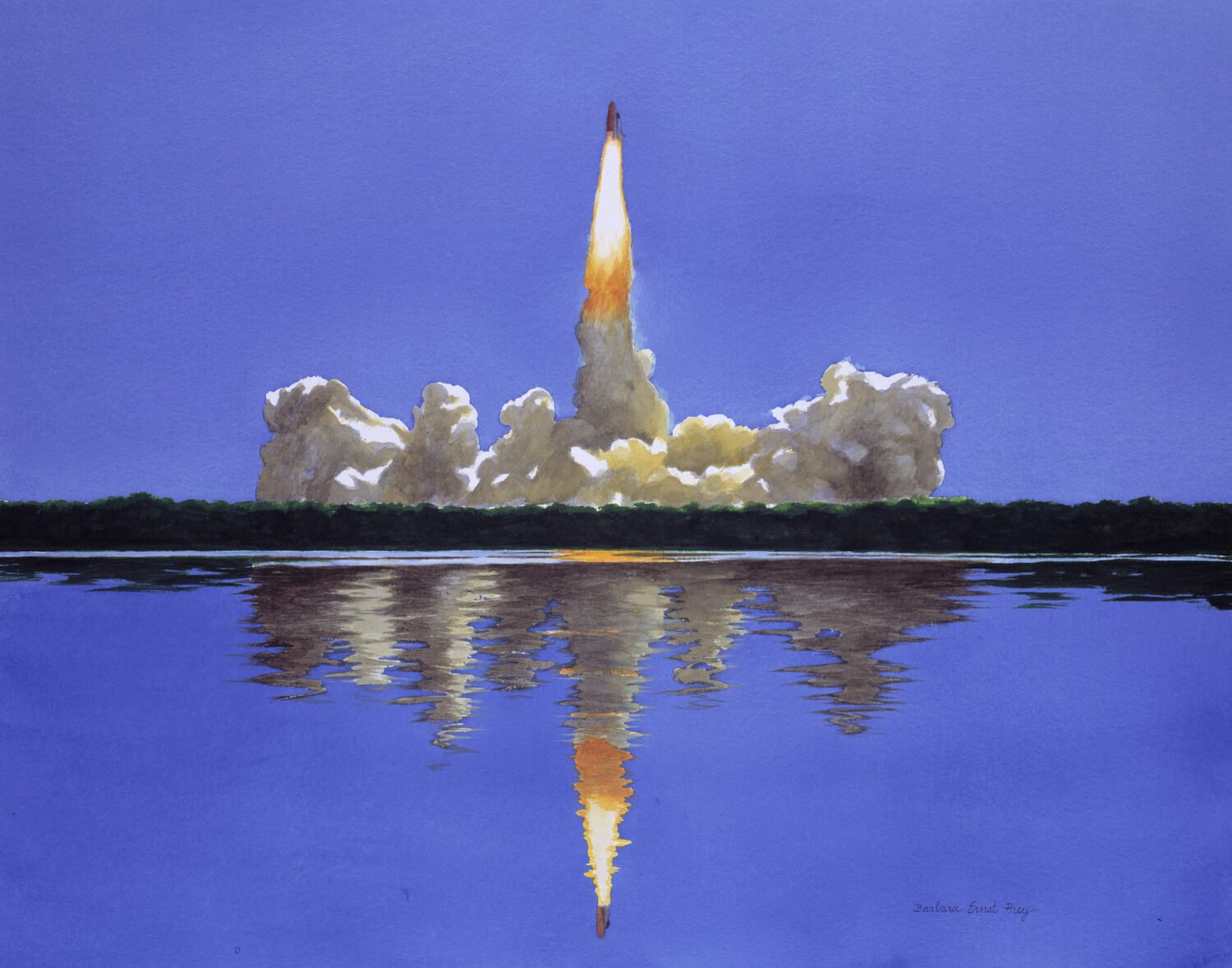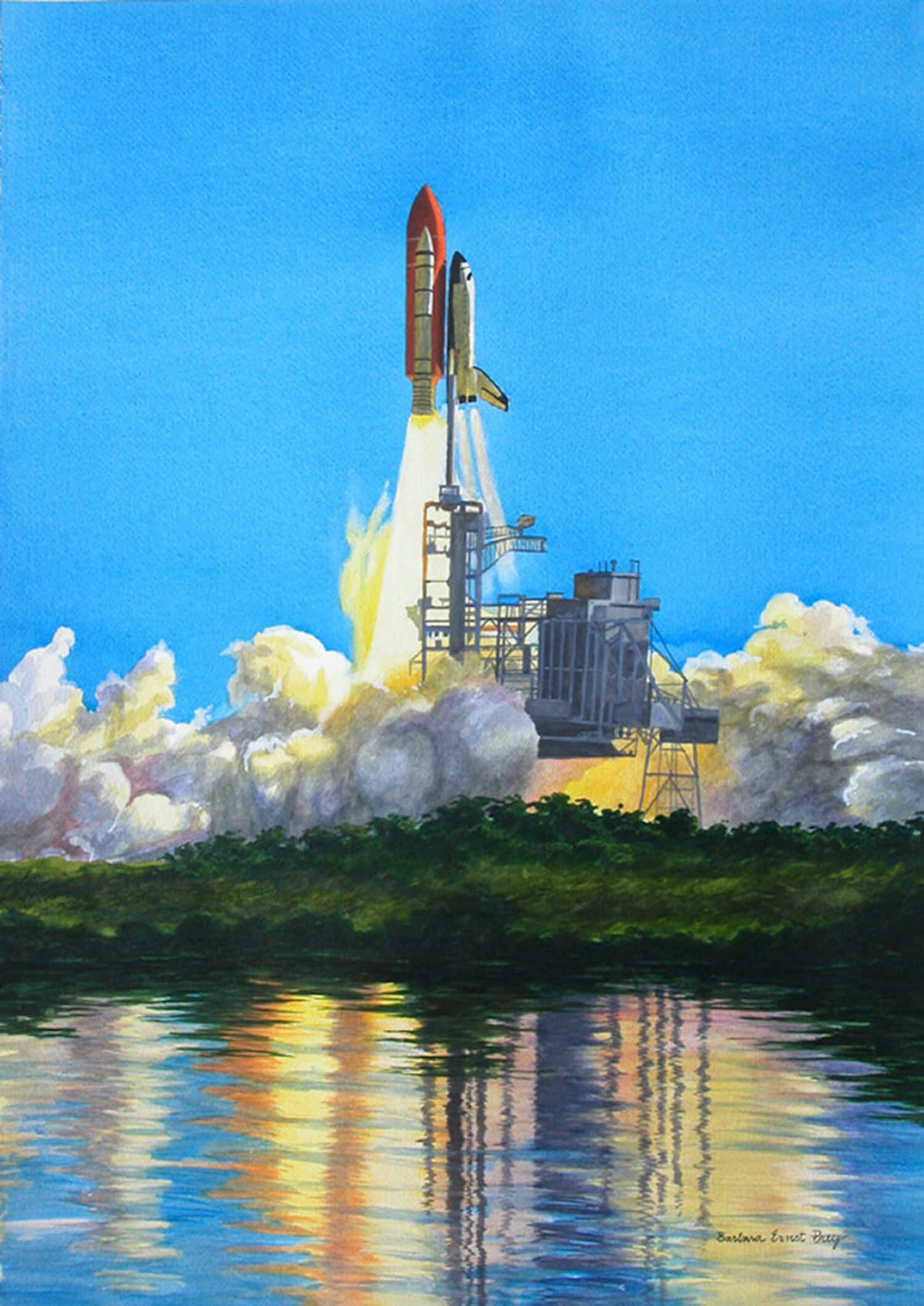This Maine Artist Never Thought She Would Paint Space Rockets. Then NASA Called.
BANGOR DAILY NEWS
By Lauren Abbate, BDN Staff
Watercolor painter Barbara Ernst Prey is widely known for her deeply colorful depictions of American landscapes. While blue skies play a central role in her paintings, Prey had never thought about painting what lies beyond those Earthly skies ― space.
But that all changed in 2001 when Prey, who summers in Port Clyde, was asked by NASA to join an impressive roster of artists who have partnered with the agency to create artistic renderings of prominent moments in space exploration history.
“They called me and they said they really liked my blues,” she said during a recent interview at her Port Clyde art gallery, referring to the shades of color she uses in her work.
Prey said she had never depicted anything beyond or blasting away from Earth, but has always been fascinated by the idea of space.
“In my era, we watched the first man walk on the moon and we all remember that moment. So NASA and space have always been very interesting to me,” Prey said. “I’m not an astronomer but I’m always out at night looking at the stars.”
Prey ended up working with NASA four times during the early 2000s to create paintings commemorating both space exploration achievements and tragedies. The exhibit currently on display at her Port Clyde gallery is titled “Light and Space” in homage to the work she did with NASA, which is currently on display across the country, and another series of work she completed based on the Hancock Shaker Village in Massachusetts.
Last month marked the 50th anniversary of the Apollo 11 moon landing, when people first walked on the moon. And while that piece of space history and countless others have been well documented through out-of-this-world photos and videos, for many years NASA also curated its history through the arts.
NASA’s Art Program began in 1962 and ran through 2010, when the program was discontinued due to lack of funding. Through the program, NASA partnered with prominent artists to commission artwork that depicted the agency’s significant missions and developments in space exploration, according to NASA multimedia director Bert Ulrich. “The first administration of NASA thought that the space age would be a very important age of discovery, and that the remnants of those eras should be included in the arts,” Ulrich said. “It gave a new perspective to the public about space.”
When Prey was first asked in 2001 to commission a painting of the International Space Station, Prey was familiar with the program largely because famous artists such as Jamie Wyeth, who also summers in Maine, and Andy Warhol also had commissioned work through the program. Painting the International Space Station was a new challenge for Prey, who typically paints on site. But the space station wasn’t yet completed. So Prey had to rely on models of the station and her own research into what the Earth and atmosphere looked like from space. In her research she picked the minds of astronauts and others working on the space station to answer questions like, “What color is the sky?” she said. “I loved [the process] because you’re learning so much,” Prey said. “[Space] puts life in perspective because it’s so vast. For me this was fascinating.” The piece that resulted from more than six months of research by Prey was a watercolor and pastel painting that shows the space station orbiting over Earth against a black and star-studded sky. The painting is currently on display at the Space Center in Houston as part of NASA’s ongoing celebration of the organization’s 60th anniversary in 2018 and the recent 50th anniversary of the Apollo 11 moon landing. Following the commission of the International Space Station, the next call Prey received from NASA was of a more somber tone.
On Feb. 1, 2003, the seven crew members aboard the Space Shuttle Columbia were killed when a damaged wing caused the spacecraft to disintegrate as it reentered Earth’s atmosphere after spending two weeks in orbit. Following the tragedy, NASA officials asked Prey to commission a painting that would serve as a tribute to the mission and the crew of the Space Shuttle Columbia.
“This painting was really hard,” Prey said. “I spent a lot of time thinking about what to do because I knew it would be an important and historic painting. I wanted to really honor the astronauts.”
Despite wanting to veer from a traditional painting of a launch, Prey knew the Columbia’s launch on Jan. 16, 2003, was the embodiment of the crew’s excitement and positivity. It was the moment they had been waiting for.
“I just kept coming back to the launch. That was the joy, the excitement. They had reached their hopes and their dreams. It was really positive at that moment,” she said.
In the Columbia tribute painting, Prey utilized her bright blues, anchoring the shuttle as it takes off surrounded by smoke and flames into the sky above the Kennedy Space Center in Cape Canaveral, Florida.
Prey would be commissioned two more times by NASA Courtesy of Barbara Ernst Prey Space Shuttle Columbia. before the program ended. Following the Columbia tribute, Prey commissioned a painting titled “Return to Flight” depicting the launch of the Shuttle Discovery. The shuttle’s launch in 2005 was the first NASA shuttle launch after the 2003 Columbia Disaster. Prey’s final commission for NASA was a painting of the experimental aircraft, X-43. The aircraft, which could travel five times the speed of sound, was the centerpiece of NASA’s hypersonic flight program.
Since working with NASA, Prey said the experience continues to influence her work by just knowing that there is so much more to the universe than what we see on Earth. “There is this huge, huge world out there and so much that we don’t know. It keeps you humble.” Prey said. “It’s amazing to me how big our universe is, but also the capacity of what we can do [to explore it].




